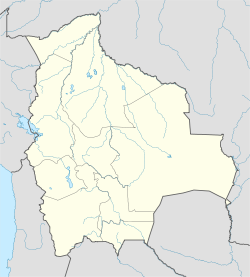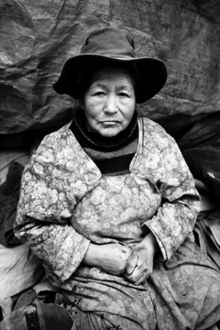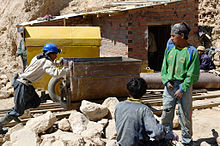- Potosí
-
For other uses, see Potosi.
Potosí 
Flag
Coat of armsLocation in Bolivia Coordinates: 19°35′S 65°45′W / 19.583°S 65.75°WCoordinates: 19°35′S 65°45′W / 19.583°S 65.75°W Country Bolivia Department Potosí Province Tomás Frías Municipality Potosí Municipality Founded April 1, 1545 Government - Mayor René Joaquino Area - Total 45.6 sq mi (118.218 km2) Elevation 13,343 ft (4,067 m) Population (2007) - Total 164,481 Time zone UTC-4 Website www.potosi.bo Official name: City of Potosí Type: Cultural Criteria: ii, iv, vi Designated: 1987 (11th session) Reference #: 420 State Party: Bolivia Region: Latin America and the Caribbean Potosí is a city and the capital of the department of Potosí in Bolivia. It is one of the highest cities in the world by elevation at a nominal 4,090 metres (13,420 ft) .[1] and it was the location of the Spanish colonial mint, now the National Mint of Bolivia. Potosí lies beneath the Cerro de Potosí—sometimes referred to as the Cerro Rico ("rich mountain")—a mountain popularly conceived of as being "made of" silver ore, which has always dominated the city. The Cerro Rico is the reason for Potosí's historical importance, since it was the major supply of silver for Spain during the period of the New World Spanish Empire. This silver was taken by llama and mule train to the Spanish Main[citation needed] whence it was then taken to Spain on the Spanish treasure fleets. Cerro de Potosí's peak is 4,824 metres (15,827 ft) above sea level.
Contents
History and silver extraction
Founded in 1546 as a mining town, it soon produced fabulous wealth, becoming one of the largest cities in the Americas and the world, with a population exceeding 200,000 people.
In Spanish there is still a saying, valer un potosí, "to be worth a potosí" (that is, "a fortune"). For Europeans, Peru—Bolivia was part of the Viceroyalty of Peru and was known as Alto Perú before becoming independent—was a mythical land of riches. Potosí appears as an idiom for "extraordinary richness" in Miguel de Cervantes' famous novel, Don Quixote (second part, cap. LXXI). One theory holds that the mint mark of Potosí (the letters "PTSI" superimposed on one another) is the origin of the dollar sign.
It is from Potosí that most of the silver shipped through the Spanish Main came. According to official records,[citation needed] 45,000 short tons (41,000 metric tons) of pure silver were mined from Cerro Rico from 1556 to 1783. Of this total, 9,000 short tons (8,200 metric tons) went to the Spanish monarchy. Due to such extensive mining, the mountain itself has diminished in height; before the mining started it was a few hundred metres higher than it is today. Indian laborers, forced by Francisco de Toledo, Count of Oropesa through the traditional Incan mita institution of contributed labor, came to die by the millions,[2] not simply from exposure and brutal labor, but by mercury poisoning: in the patio process the silver-ore, having been crushed to powder by hydraulic machinery, was cold-mixed with mercury and trodden to an amalgamation by the native workers with their bare feet.[3] The mercury was then driven off by heating, producing deadly vapors.
According to Noble David Cook, "A key factor in understanding the impact of the Potosi mita on the Indians is that mita labor was only one form of work at the mines. A 1603 report stated that of 58,800 Indians working at Potosi, 5100 were mitayos, or less than one in ten. In addition to the mitayos there were 10,500 mingas (contractual workers) and 43,200 free wage earners. Yet mitayos were required to do the work others refused: predominantly the transport of the ore up the shafts to the mouth of the mine."[4] To compensate for the diminishing indigenous labor force, the colonists made a request in 1608 to the Crown in Madrid to begin allowing the importation of 1,500 to 2,000 African slaves per year.[citation needed] An estimated total of 30,000 African slaves were taken to Potosí during the colonial era. African slaves were also forced to work in the Casa de la Moneda (mint) as acémilas humanas (human mules). Since mules would die after a couple of months pushing the mills, the colonists replaced the four mules with twenty African slaves.[5]
In 1672, a mint was established to coin silver and water reservoirs were built to fulfill the growing population's needs. At that time more than eighty-six churches were built and the city's population increased to nearly 200,000, making it one of the largest and wealthiest cities in the world.[citation needed]
After 1800, the silver mines were depleted, making tin the main product. This eventually led to a slow economic decline. Nevertheless, the mountain continues to be mined for silver to this day. Due to poor worker conditions (lack of protective equipment from the constant inhalation of dust), the miners still have a short life expectancy with most of them contracting silicosis and dying around 40 years of age.[citation needed] It is estimated that hundreds of thousands of Indians died under the harsh working conditions.[6]
During the Bolivian War of Independence (1809–1825), Potosí frequently passed between the control of Royalist and Patriot forces. Major blunders by the First Auxiliary Army from Buenos Aires (under the command of Juan José Castelli) led to an increased sense that independence was needed and fostered resentment towards him. During that occupation there was anarchy and martial excess, and Potosí became unfriendly to the point where it could not be defended.
When the second auxiliary army arrived, it was received well and the commander, Manuel Belgrano, did much to heal the past wounds inflicted by the tyrannical Castelli. When that army was forced to retreat, Belgrano took the calculated decision to blow up the Casa de la Moneda. Since the locals refused to evacuate, the explosion would have resulted in many casualties. The fuse was lit, but disaster was averted by locals who put the fuse out. Two more expeditions from Buenos Aires would seize Potosí.
Origin of the name
There is no authoritative etymology for the word "Potosí." According to legend, in about 1462, Huayna Capac, the eleventh Sapa Inca of what by then was known as the Inca Empire "set out for Ccolque Porco and Andaccaua, the location of his mines from which were taken innumerable arrobas of silver" (an arroba is a Spanish unit of weight equivalent to approximately 25 pounds (11 kg)). "Before leaving there, he saw [Potosí], and admiring its beauty and grandeur, he said (speaking to those of his Court): 'This doubtless must have much silver in its heart'; whereby he subsequently ordered his vassals to go to Ccolque Porco ... and work the mines and remove from them all the rich metal. They did so, and having brought their tools of flint and reinforced wood, they climbed the hill; and after having probed for its veins, they were about to open those veins when they heard a frightening thunderous noise which shook the whole hill, and after this, they heard a voice which said: 'Do not take the silver from this hill, because it is destined for other masters.' Amazed at hearing this reasoning, the Incan vassals desisted in their purpose and returned to Porco and told the king what had happened; relating the occurrence in their own language, on coming to the word noise, they said 'Potocsí' which means there was a great thunderous noise, and from that later was derived (corrupting a letter) the name of potosí."[citation needed]
It is believed that "Potosí" is a Quechua word.[citation needed] However, in Quechua the phoneme p'otoj does not refer to a thunderous noise, whereas it does in Aymara. Thus, if Potosí encompasses the idea of a thunderous noise, the locution would have an Aymaran root rather than a Quechuan.[citation needed] The actual sharp structure of the term is contrary to the nature of both Aymara and Quechua. Another explanation, given by several Quechua speakers,[specify] is that potoq is an onomatopoeic word that reproduces the sound of the hammer against the ore, and oral tradition has it that the town derived its name from this word.
Legacy
The city of San Luis Potosí in Mexico was named after Potosí in Bolivia. In the United States, the name Potosi was optimistically given to lead-mining towns of Potosi, Wisconsin [7] and Potosi, Missouri, and also to the silver-mining town of Potosi, Nevada.
Sister cities
See also
- Geology of Bolivia
- Tinku – A local combat ritual and agricultural fertility rite
Gallery
-
Potosi, the first image in Europe. Pedro Cieza de Leon, 1553.
References
- ^ Bolivia & Main Cities / Potosí from boliviaweb.com. Retrieved 2010-09-27.
- ^ Eduardo Galeano, "The Open Veins of Latin America", illustrates that 8 million Indians died at Potosi alone.
- ^ Fernand Braudel, The Wheels of Commerce 1982, vol. II of Civilization and Capitalism illustrates the process (p. 326) in an eighteenth-century drawing in the library of the Hispanic Society of New York.
- ^ Cook, Noble David (1981). Demographic collapse, Indian Perú, 1520-1620. Cambridge University Press. p. 237. ISBN 0521239958. http://books.google.com/books?id=V_0YqnzZeKYC&pg=&dq#v=onepage&q=&f=false.
- ^ Angola Maconde, 1999
- ^ John Demos, The high place: Potosi. Retrieved 9 March 2010.
- ^ "Potosi [origin of place name]". Wisconsinhistory.org. 1941-10-10. http://www.wisconsinhistory.org/dictionary/index.asp?action=view&term_id=3777&keyword=potosi. Retrieved 2010-04-13.
Specific:
General:
- Angola Maconde, Juan. "Raíces de un pueblo: cultura afroboliviana." La Paz: Producciones CIMA, 1999.
- Arzáns de Orsúa y Vela, Bartolomé. Historia de la Villa Imperial de Potosí. Edición de Lewis Hanke y Gunnar Mendoza. Providence, R.I.: Brown University Press, 1965.
- Cobb, Gwendolin Ballantine. "Potosí, a South American Mining Frontier." Greater America: Essays in Honor of Herbert Eugene Bolton. Freeport, N.Y.: Books for Libraries Press, 1968, © 1945, pp. 39–58.
- Hanke, Lewis. The Imperial City of Potosí. The Hague: Nijhoff, 1956.
External links
 Potosí Department
Potosí DepartmentCapital: Potosí Provinces 
Municipalities (and seats) Acasio (Acasio) • Arampampa (Arampampa) • Atocha (Atocha) • Betanzos (Betanzos) • Caiza "D" (Caiza "D") • Ckochas (Ckochas) • Caripuyo (Caripuyo) • Chaquí (Chaquí) • Chayanta (Chayanta) • Chuquihuta (Chuquihuta) • Colcha "K" (Colcha "K") • Colquechaca (Colquechaca) • Cotagaita (Cotagaita) • Llallagua (Llallagua) • Llica (Llica) • Mojinete Municipality (Mojinete) Ocurí (Ocurí) • Pocoata (Pocoata) • Porco (Porco) • Potosí (Potosí) • Puna (Puna) • Ravelo (Ravelo) • Sacaca (Sacaca) • San Agustín (San Agustín) • San Antonio de Esmoruco (San Antonio de Esmoruco) • San Pablo de Lípez (San Pablo de Lípez) • San Pedro de Buena Vista (San Pedro de Buena Vista) • San Pedro de Quemes (San Pedro de Quemes) • Tacobamba (Tacobamba) • Tahua (Tahua) • Tinguipaya (Tinguipaya) • Tomave (Tomave) • Toro Toro (Toro Toro) • Tupiza (Tupiza) • Uncía (Uncía) • Urmiri (Urmiri) • Uyuni (Uyuni) • Villazón (Villazón) • Vitichi (Vitichi) • Yocalla (Yocalla)World Heritage Sites in Bolivia Jesuit Missions of the Chiquitos · Fuerte de Samaipata · Noel Kempff Mercado National Park · City of Potosí · Historic City of Sucre · Tiwanaku: Spiritual and Political Centre of the Tiwanaku Culture
 Categories:
Categories:- World Heritage Sites in Bolivia
- Potosí
- Populated places established in 1546
Wikimedia Foundation. 2010.











